Wednesday, July 16. 2014
The Shadow Internet That’s 100 Times Faster Than Google Fiber
Via Wired
-----

Illustration: dzima1/Getty
When Google chief financial officer Patrick Pichette said the tech giant might bring 10 gigabits per second internet connections to American homes, it seemed like science fiction. That’s about 1,000 times faster than today’s home connections. But for NASA, it’s downright slow.
While the rest of us send data across the public internet, the space agency uses a shadow network called ESnet, short for Energy Science Network, a set of private pipes that has demonstrated cross-country data transfers of 91 gigabits per second–the fastest of its type ever reported.
NASA isn’t going bring these speeds to homes, but it is using this super-fast networking technology to explore the next wave of computing applications. ESnet, which is run by the U.S. Department of Energy, is an important tool for researchers who deal in massive amounts of data generated by projects such as the Large Hadron Collider and the Human Genome Project. Rather sending hard disks back and forth through the mail, they can trade data via the ultra-fast network. “Our vision for the world is that scientific discovery shouldn’t be constrained by geography,” says ESnet director Gregory Bell.
In making its network as fast as it can possibly be, ESnet and researchers are organizations like NASA are field testing networking technologies that may eventually find their way into the commercial internet. In short, ESnet a window into what our computing world will eventually look like.
The Other Net
The first nationwide computer research network was the Defense Department’s ARPAnet, which evolved into the modern internet. But it wasn’t the last network of its kind. In 1976, the Department of Energy sponsored the creation of the Magnetic Fusion Energy Network to connect what is today the National Energy Research Scientific Computing Center with other research laboratories. Then the agency created a second network in 1980 called the High Energy Physics Network to connect particle physics researchers at national labs. As networking became more important, agency chiefs realized it didn’t make sense to maintain multiple networks and merged the two into one: ESnet.
The nature of the network changes with the times. In the early days it ran on land lines and satellite links. Today it is uses fiber optic lines, spanning the DOE’s 17 national laboratories and many other sites, such as university research labs. Since 2010, ESnet and Internet2—a non-profit international network built in 1995 for researchers after the internet was commercialized—have been leasing “dark fiber,” the excess network capacity built-up by commercial internet providers during the late 1990s internet bubble.
An Internet Fast Lane
In November, using this network, NASA’s High End Computer Networking team achieved its 91 gigabit transfer between Denver and NASA Goddard Space Flight Center in Greenbelt, Maryland. It was the fastest end-to-end data transfer ever conducted under “real world” conditions.
ESnet has long been capable of 100 gigabit transfers, at least in theory. Network equipment companies have been offering 100 gigabit switches since 2010. But in practice, long-distance transfers were much slower. That’s because data doesn’t travel through the internet in a straight line. It’s less like a super highway and more like an interstate highway system. If you wanted to drive from San Francisco to New York, you’d pass through multiple cities along the way as you transferred between different stretches of highway. Likewise, to send a file from San Francisco to New York on the internet—or over ESnet—the data will flow through hardware housed in cities across the country.

A map of ESnet’s connected sites. Image: Courtesy of ESnet
NASA did a 98 gigabit transfer between Goddard and the University of Utah over ESnet in 2012. And Alcatel-Lucent and BT obliterated that record earlier this year with a 1.4 terabit connection between London and Ipswich. But in both cases, the two locations had a direct connection, something you rarely see in real world connections.
On the internet and ESnet, every stop along the way creates the potential for a bottleneck, and every piece of gear must be ready to handle full 100 gigabit speeds. In November, the team finally made it work. “This demonstration was about using commercial, off-the-shelf technology and being able to sustain the transfer of a large data network,” says Tony Celeste, a sales director at Brocade, the company that manufactured the equipment used in the record-breaking test.
Experiments for the Future
Meanwhile, the network is advancing the state of the art in other ways. Researchers have used it to explore virtual network circuits called “OSCARS,” which can be used to create complex networks without complex hardware changes. And they’re working on what are known as network “DMZs,” which can achieve unusually fast speeds by handling security without traditional network firewalls.
These solutions are designed specifically for networks in which a small number of very large transfers take place–as opposed to the commercial internet where lots of small transfers take place. But there’s still plenty for commercial internet companies to learn from ESnet. Telecommunications company XO Communications already has a 100 gigabit backbone, and we can expect more companies to follow suit.
Although we won’t see 10-gigabit connections—let alone 100 gigabit connections—at home any time soon, higher capacity internet backbones will mean less congestion as more and more people stream high-definition video and download ever-larger files. And ESnet isn’t stopping there. Bell says the organization is already working on a 400 gigabit network, and the long-term goal is a terabyte per second network, which about 100,000 times faster than today’s home connections. Now that sounds like science fiction.
Update 13:40 EST 06/17/14: This story has been updated to make it clear that ESnet is run by the Department of Energy.
Update 4:40 PM EST 06/17/14: This story has been updated to avoid confusion between ESnet’s production network and its more experimental test bed network.
Tuesday, July 15. 2014
This Band Of Small Robots Could Build Entire Skyscrapers Without Human Help
Via Fast Company
-----
Even though most buildings are designed using the latest digital tools, actual construction is stuck in the past; building is messy, slow, and inefficient. 3-D printing might change that, but recent projects like these printed houses in China demonstrate one of the technical challenges--the equipment itself has to be gigantic, because it can’t work unless it’s bigger than the building itself.
A team of researchers from Institute for Advanced Architecture of Catalonia are working on another solution: A swarm of tiny robots that could cover the construction site of the future, quickly and cheaply building greener buildings of any size.
The robots work in teams to squirt out material that hardens into the shell of the building. Foundation robots move in a track, building up the first 20 layers of the structure, and then a series of "grip" robots clamp on the top or sides adding more layers, ceilings, and frames for windows or doors. Vacuum robots attach on at the end to add a layer to reinforce everything.
Other 3-D-printed architecture requires frames, which have to fit entirely around a building, or robotic arms that can only reach as high as themselves. “If you want to make an object as big as a stadium or a skyscraper you’ll need to design a machine bigger than that object in at least one axis,” explain researchers Petr Novikov and Sasa Jokic. “Making such machines isn’t economically reasonable, sustainable, and, in some cases, simply impossible due to their size.”
The Minibuilders could in theory build anything. “The robots can work simultaneously while performing different tasks, and having a fixed size they can create objects of virtually any scale, as far as material properties permit,” say Novikov and Jokic. “They are extremely easy to transport to the site. All these features make them incredibly efficient and reduce environmental footprint of construction.”
Because the technology wouldn't require custom molds or even support structures, there would be zero construction waste. It could also save materials by printing a little extra only in places where the building needs more support.
Eventually, the designers see the robots being used to take care of pretty much every conceivable construction task. "They are an ecology of small construction robots, and this ecology can be extended far beyond 3-D printing," the researchers say. "In the future, we envision robots that do also painting, piping, and variety of other tasks."
Novikov and Jokic, along with fellow researchers Shihui Jin, Stuart Maggs, Cristina Nan, Dori Sadan, are sharing their design plans to encourage others to build on it.
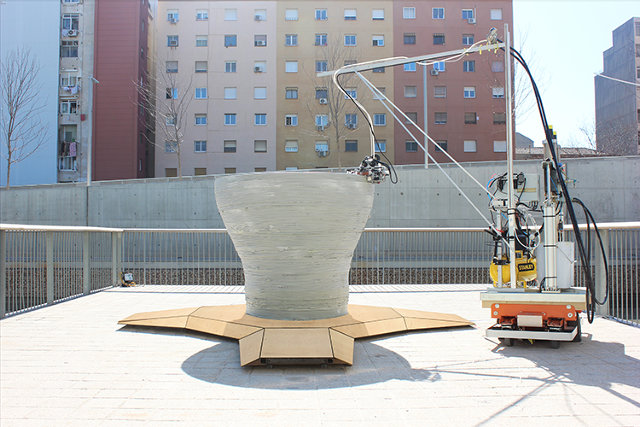
Monday, July 14. 2014
Inside Shapeways, the 3D-Printing Factory of the Future
Via Gizmodo
-----
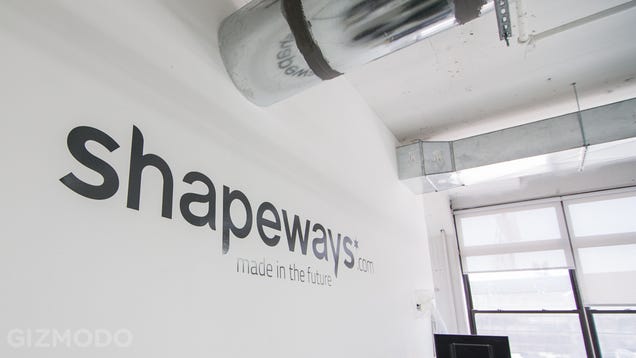
When you walk into the Shapeways headquarters in a sprawling New York City warehouse building, it doesn't feel like a factory. It's something different, somehow unforgettable, inevitably new. As it should be. This is one of the world's first full service 3D-printing factories, and it's not like any factory I've ever seen.
Founded in the Netherlands in 2007 as a spinoff of Philips electronics, Shapeways is a truly unique and delightfully simple service. If you want an object 3D-printed, all you have to do is upload the design's CAD file to Shapeways' website, pay a fee that mostly just covers the cost of materials, and then wait. In a few days, Shapeways will send the 3D-printed object to you, nicely bubble-wrapped and ready for use. It's effectively an on-demand manufacturing service, a factory at your fingertips in a way that's wonderfully futuristic.
Aside from the windows that look on to the factory floor, Shapeways HQ looks just like any other start-up office. Colorful chairs surround laptop-littered desks. Employees drinking seltzer linger around a long lunch table in the back. It's oddly quiet, and everything is coated in a fine layer of white dust, the cast-off material that didn't quite make it into an object of its own.
If you didn't know any better, you'd think it was some sort of art studio littered with hulking machines, perhaps for firing pottery or something. In fact, each of these closet-sized machines costs upwards of $1 million and can 3D print about 100 objects at a time. Shapeways names all of them after old women because they require lots of care. The entire cast of Golden Girls is represented.
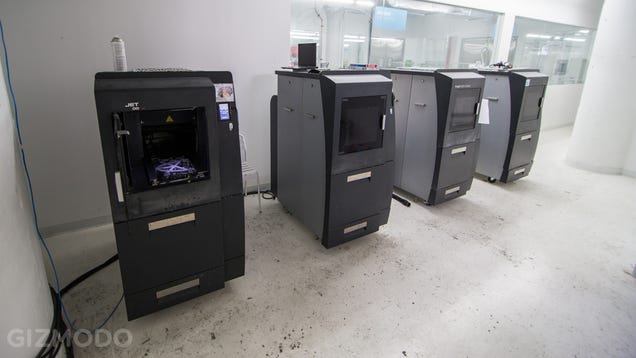 Expand
Expand
There's actually not much to see inside the machines. A small window offers a peek into the actual printing area, an unassuming expanse of white powder that lights up every few seconds. Shapeways uses selective laser sintering (SLS) printers that enable them to print many objects at once and product higher quality products than some other additive manufacturing techniques.
That white powder lingering everywhere is the raw material for a 3D-printed object. The box lights up because a series of lasers are actually sintering the plastic in specific spots, as dictated by the design. An arm then moves over the surface, adding another layer of powder. Over the course of several hours, the sintered plastic becomes an object that's supported by the excess powder. The process look almost surgical if you're not familiar with the specifics of exactly what's going on.
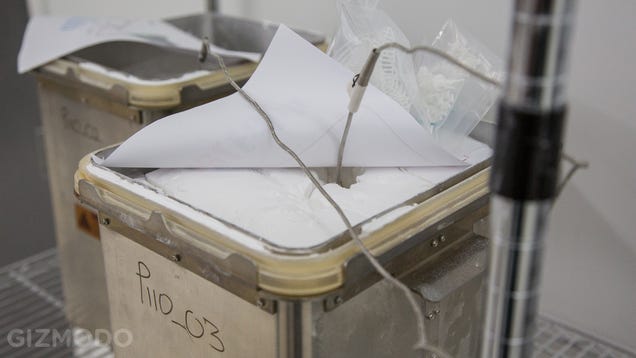 Expand
Expand
But, the printers don't just spit out objects ready to go. The finished product is actually a large white cube that's carefully moved from the machine to a nearby cooling rack. After all, it was just blasted with a bunch of hot lasers. Eventually, it's up to a human to break apart the cube and find dozens of newly printed objects in the powder. It's almost like digging for dinosaur bones. As Shapeways' Savannah Peterson explained to me, "You feel like an archaeologist even if you're just watching."
 Expand
Expand
She's right. After I made my way around the factory floor, which is roughly half the size of a basketball court, I got a peek at this process. The guy doing the digging was wearing a protective jump suit and a large ventilator to keep from inhaling the powder. And despite the fact that large plastic curtains contained the breakout room, the powder gets everywhere. Suddenly, the light coating of dust that covers the whole factory made even more sense. By the end of the tour, I looked like a baker covered in flour.
That's about as messy as it gets, though. The rest of the process is remarkably clean and streamlined, yielding some pretty incredible objects made not only out of plastic but also vari. The Shapeways website is full of curiosities, from delicate jewelry that can be printed in sterling silver to physical manifestations of internet memes that are printed in color using a special printer that can handle rainbow hues.
Tuesday, July 08. 2014
LaMetric Is A Smart And Hackable Ticker Display
Via TechCrunch
-----

Ever since covering Fliike, a beautifully-designed physical ‘Like’ counter for local businesses, I’ve been thinking about how the idea could be extended, with a fully-programmable, but simple, ticker-style Internet-connected display.
A few products along those lines do already exist, but I’ve yet to find anything that quite matches what I had in mind. That is, until recently, when I was introduced to LaMetric, a smart ticker being developed by UK/Ukraine Internet of Things (IoT) startup Smart Atoms.
Launching its Kickstarter crowdfunding campaign today, the LaMetric is aimed at both consumers and businesses. The idea is you may want to display alerts, notifications and other information from your online “life” via an elegant desktop or wall-mountable and glance-able display. Likewise, businesses that want an Internet-connected ticker, displaying various business information, either publicly for customers or in an office, are also a target market.
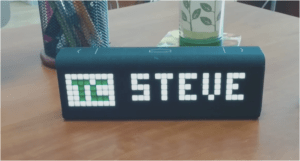
The device itself has a retro, 8-bit style desktop clock feel to it, thanks to its ‘blocky’ LED light powered display, which is part of its charm. The display can output one icon and seven numbers, and is scrollable.
But, best of all, the LaMetric is fully programmable via the accompanying app (or “hackable”) and comes with a bunch of off-the-shelf widgets, along with support for RSS and services like IFTTT, Smart Things, Wig Wag, Ninja Blocks, so you can get it talking to other smart devices or web services. Seriously, this thing goes way beyond what I had in mind — try the simulator for yourself — and, for an IoT junkie like me, is just damn cool.
Examples of the kind of things you can track with the device include time, weather, subject and time left till your next meeting, number of new emails and their subject lines, CrossFit timings and fitness goals, number of to-dos for today, stock quotes, and social network notifications.
Or for businesses, this might include Facebook Likes, website visitors, conversions and other metrics, app store rankings, downloads, and revenue.
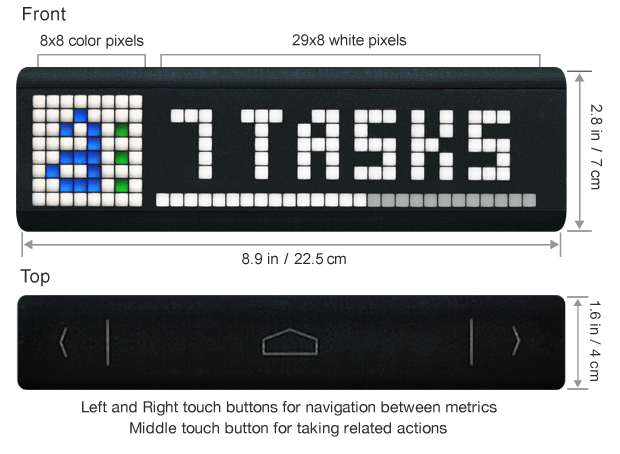
In addition to the display, the device has back and forward buttons so you can rotate widgets (though these can be set to automatically rotate), as well as an enter key for programmed responses, such as accepting a calendar invitation.
There’s also a loudspeaker for audio alerts. The LaMetric is powered by micro-USB and also comes as an optional and more expensive battery-powered version.
Early-bird backers on Kickstarter can pick up the LaMetric for as little as $89 (plus shipping) for the battery-less version, with countless other options and perks, increasing in price.
Thursday, July 03. 2014
Keren Elazari: Hackers: the Internet's immune system
Via TED
-----
Published on Jun 10, 2014
The beauty of hackers, says cybersecurity expert Keren Elazari, is that they force us to evolve and improve. Yes, some hackers are bad guys, but many are working to fight government corruption and advocate for our rights. By exposing vulnerabilities, they push the Internet to become stronger and healthier, wielding their power to create a better world.Wednesday, July 02. 2014
deviantART Makes Its Case For Administering The .Art Domain
Via Tech Crunch
-----

Online artists’ community deviantART is hoping to become responsible for the new .art web domains, and it recently sent a letter to ICANN (the organization responsible for managing top level domains) laying out its perspective on the stakes in the decision.
The letter also presents deviantART’s case for why it deserves a “community designation” in the application process, saying:
“We are on the cusp of an extraordinary opportunity with the simple use of a single word: a virtual place within the Internet for the arts and a virtual palace to the arts built site-by-site by millions of artists and art institutions each with an individualized artistic contribution gathered around the simple namespace of ‘.ART.’”
The letter adds that if the domain is exploited commercially, “it will only occasionally and haphazardly designate the arts themselves. It will not be a welcomed location for the arts.”
That may seem like an unusual argument coming from a for-profit business, but deviantART has created a new subsidiary called Dadotart (apparently that’s standard procedure when applying to manage a new top level domain), and it says it would create a policy board of “artists and art institutions” that would establish the standards for when the .art designation can be used.
deviantART says ICANN is currently deciding whether it deserves the community designation, which would give it priority in the application process. The initial signs may have not been entirely positive, as the letter states: “We believe preservation of the arts is at risk based upon the results of the initial community evaluations made by ICANN that clearly disfavor their approval with a resulting and evident bias towards commercialization.”
If you aren’t familiar with deviantART, the site showcases digital art, traditional art, photography — sometimes original and sometimes inspired by existing media properties — and it says it has 31 million registered users. (Software company Autodesk became an investor last year.)
e-flux, a network of art professionals, is also applying for a community designation, and although the applications can’t be combined, deviantART says the two groups support each other’s applications and would be involved in policy issues if either gets awarded the domain.
Anyway, you can read deviantART’s application here and see all the .art applications here (sort the list by “string’). And here’s the full letter:
-----
[Submitted to ICANN May 21, 2014 by deviantART on behalf of its applicant, Dadotart, Inc., for the .ART gTLD]
SAVE DOT ART
ICANN has a choice: it can promote the arts or destroy their common identity.
“.ART “ can become an authentic Internet address for the arts and represent its community. We are on the cusp of an extraordinary opportunity with the simple use of a single word: a virtual place within the Internet for the arts and a virtual palace to the arts built site-by-site by millions of artists and art institutions each with an individualized artistic contribution gathered around the simple namespace of “.ART.” The .ART gTLD can become a touchstone of world culture and contribute transformative vision across all boundaries.
But left to pure commercial exploitation, .ART will stand as a complete failure. It will only occasionally and haphazardly designate the arts themselves. It will not be a welcomed location for the arts. The impact of the worldwide abuse of a beloved term through disjointed, disorganized, and random designations – - completely irrelevant to its meaning and associations – - would be an irretrievable tragedy.
There are two applicants for .ART, which have elected community designation, DeviantArt and e-flux who mutually support each other’s applications. Eight other, purely commercial, entities and individuals have chosen to oppose or stand in the way of that joint effort.
We believe preservation of the arts is at risk based upon the results of the initial community evaluations made by ICANN that clearly disfavor their approval with a resulting and evident bias towards commercialization.
DeviantArt has over 31 million registered members and an audience exceeding 60 million unique visitors a month all drawn to the arts. It is one of the top 150 Internet sites in the world measured by traffic. E-flux is a network of over 100,000 art institutions and professional artists, curators, and practitioners.
DeviantArt and e-flux are committed. We stand prepared to convene a Policy Board of the most passionate and essential artists and art institutions to first debate and then establish standards for the use of the .ART address. As representatives of the community of the arts, we are prepared to initiate a gTLD for the arts, by the arts, and with the arts.
We call upon the ICANN Board to intervene on behalf of the arts. We ask the Board to recognize the .ART gTLD’s unique and substantial value as a world cultural monument and to dedicate its management to trusted, proven organizations that have introduced and guided the arts to the World Wide Web since its inception.
We call upon ICANN to set aside its unlimited and seemingly unrestrained commercialization of the Internet name space and embrace the opportunity that it hardcoded into its guidebook for applicants to self-identify as a community. ICANN must choose to promote the arts rather than destroy their common identity.
We call upon the Government Advisory Committee to the ICANN Board to safeguard the arts as a universal human right in its shared culture. We call upon the GAC to insist upon the recognition of valid community interests in the assignment of gTLDs by ICANN’s management in line with the GAC’s own requests to ICANN at the Singapore meetings held in March of this year.
And through DeviantART we call upon the world community of the arts to make itself known and rise to the defense of its own integrity and good name.
#savedotart #deviantart
Quicksearch
Popular Entries
- The great Ars Android interface shootout (130673)
- Norton cyber crime study offers striking revenue loss statistics (100895)
- MeCam $49 flying camera concept follows you around, streams video to your phone (99679)
- Norton cyber crime study offers striking revenue loss statistics (57124)
- The PC inside your phone: A guide to the system-on-a-chip (56965)
